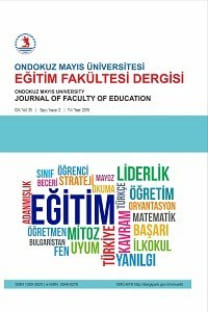Edebiyat Öğretiminde Görsel Araç Kullanımı: Kısa Öykü Örneği
Bu çalışmanın amacı görsel araçlı bir edebiyat dersinin işlenişini süreç ve sonuçlarıyla birlikte tanımlamak ve edebiyat öğretiminde görsel araçların önemini vurgulamaktır. Kısa bir öykü ve onun analizinde kullanılan terim ve bilgileri öğretmede kullanılan görsel araçlı bu öğretim planında edebî kavram ve dönemler okuma öncesi ve okuma süreci etkinlikleri yoluyla görsel araçlarla desteklenmiş ortamlarda öğretilmiş ve öğrencilerin uygulamaya yönelik izlenimleri ve bireysel gelişimlerini değerlendirmeleri açık uçlu sorular yardımıyla elde edilmiştir. Yazılı yoklamalardan elde edilen sonuçlar da karşılaştırılmış ve uygulama grubunun sınavları arasındaki ortalamalarının daha büyük fark olduğu görülmüştür. Öğrenci ve öğreticinin izlenim ve değerlendirmeleri ile sınama aracı yöntemiyle elde edilmiş bulunan araştırma sonuçları görsel araçlarla desteklenmiş edebiyat derslerinin öğrenci başarısını artırdığını ve dersin işlenmesi için olumlu ortamlar yarattığını göstermiştir.
Visual Materials in the Teaching of Literature: A Short Story Application
The aim of this paper is to introduce and discuss a literature class in which visual materials were used to support and enhance the learning of literature. In this short story teaching plan, which aims at teaching relevant terminology and the literary period, visual materials were used in prereading and in-reading stages, and students’ opinions on the teaching process were collected through a questionnaire containing open-ended questions. Two tests measured students’ success in the learning of these items, and it was found that the difference between the scores of the experiment group showed greater difference. The findings of this study, which were gathered through the teacher’s and students’ observations and evaluations, suggest that literature teaching supported by visual materials increases success and helps creating a positive classroom atmosphere.
___
- Açıkgöz, K. Ü. (2003). Aktif Öğrenme. İzmir: Eğitim Dünyası Yayınları.
- Arıkan, A. (2005). Students’ evaluation of literature courses in the English language teacher education curriculum in Turkey. Ondokuz Mayıs University Journal of Education (20), 77-85.
- Canning-Wilson, C. (1999). Using pictures in EFL and ESL classrooms. Paper presented at the Current Trends in English Language Testing Conference. (ERIC No. ED445526)
- Ellis, G. (2006). Motivating pupils to read 2. Retrieved March 4, 2006 from http://teachingenglish.org.uk/think/literature/motivate_read2.shtml
- El-Tigi, M. A., Lewis, B. A. &, Mac Entee, V. M. (1996). Perception of elementary students of visuals on the web (Report no. IR018362). (ED408949).
- Hammerberg, D. (2001). Reading and writing "hypertextually": Children's literature, technology, and early writing instruction. Language Arts, 78, 207-215.
- Hare, C. (1979). Hilary’s Aunt. In Modern Short Stories. (Ed. G. C. Thornley). Hong Kong: Longman.
- Hobbs, R. (1997). Literacy for the information age. In J. Flood, S.B. Heath, & D. Lapp (Eds.), Research on teaching literacy through the communicative and visual arts (pp. 7-13). New York: Simon & Schuster Macmillan.
- Urgan, M. (2003). İngiliz edebiyatı tarihi. İstanbul: Yapı Kredi Yayınları.
- ISSN: 1300-302X
- Yayın Aralığı: Yılda 2 Sayı
- Başlangıç: 1986
- Yayıncı: Ondokuz Mayıs Üniversitesi Eğitim Fakültesi
Sayıdaki Diğer Makaleler
İlköğretim 7. Sınıf Öğrencilerinin Medya ve Medya Okuryazarlığı Dersine İlişkin Tutumları
Özcan PALAVAN, Şakir ÇINKIR, Elif MERCAN, Alper KESTEN, Cevat ELMA, Abdullah Nuri DİCLE
Öğretmen Adaylarının Bilimsel Epistemolojik İnançlarının İncelenmesi
Didem İNAL, Ali Günay BALIM, Teoman KESERCİOĞLU, Ertuğ EVREKLİ
Biyoloji Öğretimi İçin Hazırlanmış Eğlenceli Eğitim Yazılımı Değerlendirmesi
Edebiyat Öğretiminde Görsel Araç Kullanımı: Kısa Öykü Örneği
